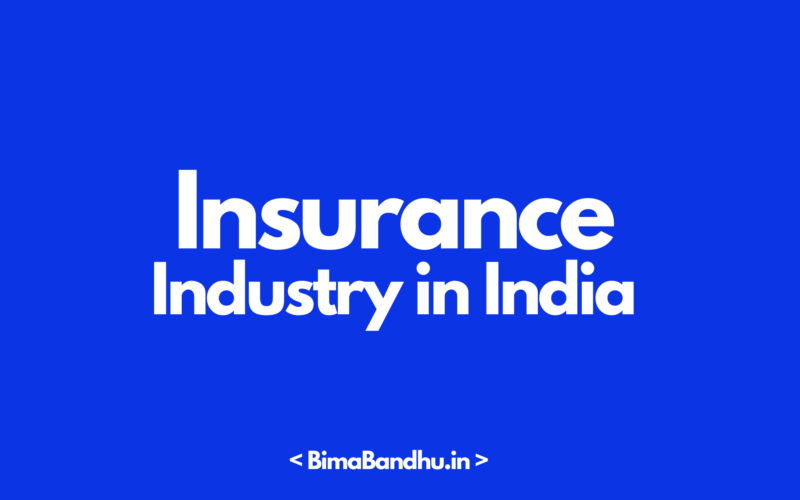The insurance industry in India is one of the business sectors that has been on an upward growth trajectory. The line of growth of the insurance sector in India can be attributed to the rising awareness about the need for insurance among the masses and growing incomes. The recent years have been phenomenal at the rate of 32-34% every year for the industry, making India the first largest life insurance market in many of the emerging insurance markets of the world.
While these numbers might paint a brighter picture of the insurance industry in India, it has its fair share of challenges and competition. Let’s dive deeper to know about the Indian insurance market.
- The insurance industry in India consists of 57 insurance companies in total – 24 of which are in the life insurance business, while there are 34 non-life insurers.
- In the life insurance industry in India, Life Insurance Corporation, popularly known as LIC is the sole public sector company.
- Six public sector insurance companies also exist in the non-life insurance industry in India, out of which there are two specialized insurers: Agriculture Insurance Company Ltd. (crop insurance) and Export Credit Guarantee Corporation of India (credit insurance).
- General Insurance Corporation of India (GIC Re) is the sole national re-insurer in the country.
- Agents (both individual and corporate), surveyors, brokers, and third-party administrators are some of the stakeholders in the Indian insurance market.
Market Size of the Insurance Industry in India – Question and Answers
What is insurance penetration in India?
The insurance penetration in the country stood at 4.2% in the financial year 2021 (including 3.2% life insurance penetration and 1.0% non-life insurance penetration).
What is the insurance density of the Indian insurance market?
Insurance density is calculated as the insurance premium (in US$) to the total population in a country. India’s overall insurance density was US$ 78 in 2021. Here, the life insurance density in the country was US$ 59 while the non-life insurance density was US$ 19 (Source: Statista).
What are some notable life insurance industry statistics?
- As per the IBEF, the premiums from the life insurance industry are now expected to reach US$ 317.98 billion or Rs. 24 lakh crore by 2031.
- Until the month of Oct 2022 in FY2023, the total premiums from life insurance companies (new business) in India stood at US$ 25.3 billion.
- As per Life Insurance Council Data, the new business premiums of life insurers in Oct 2022 grew to US$ 1.94 billion or Rs. 15,920.13 crores.
- The gross first-year premium collected by life insurance companies in India increased to US$ 40.06 billion in 2021-22 – representing a 12.93% surge.
Source: IBEF
|
What are some notable non-life insurance industry statistics?
- During the period Apr 2021 to Mar 2022, the gross premiums written off by the non-life insurance companies in India reached the mark of US$ 28.14 billion – representing an 11.1% increase over the same period in FY2021.
- The total premium earned by the non-life insurance sector in India stood at US$ 4.61 billion in May 2022 – representing a 24.15% increase as compared to the same period in the last year.
- The market share of private sector companies in the non-life insurance industry in India increased from 48.03% to 49.31% in the financial year 2021.
- Standalone private sector health insurers registered a rise in gross premium at the rate of 66.6% in May 2021 to reach US$ 191.84 million.
Source: IBEF
Easy to Digest Stats:India is also the second largest insurtech (short for insurance technology) market in the Asia Pacific region, accounting for more than one-third (35%) of US$ 3.66 billion insurtech-focused venture investments, as per the S&P Global Market Intelligence Data. |
Government Initiatives Related to the Insurance Industry in India
Given below are some of the initiatives taken by the Government of India to give a boost to the Indian insurance market:
- The government sold a 7% stake in the Life Insurance Corporation (LIC) for Rs. 50,000 crores in 2022, making it the largest IPO (Initial Public Offering) in the country.
- The government also signed an agreement for a US$ 40 million project with the World Bank in Nov 2021 to improve the quality of healthcare services in the eastern state of Meghalaya.
- The Union Cabinet approved an investment of Rs. 6,000 crores into entities providing export insurance cover in Sep 2021. This was done to facilitate additional exports over the next five years.
- The Indian Parliament passed the General Insurance Business Amendment Bill in Aug 2021 for the privatization of state-run general insurance companies.
- Under the Union Budget 2021, the FDI limit was increased from 49% to 74%.
- The finance ministry announced an infusion of Rs.3,000 crore into state-owned General Insurance companies to improve their overall financial health.
What Paves the Road Ahead for the Insurance Industry in India?
- The life insurance industry in India is expected to grow by 14-15% per year for the next five years.
- Currently, more than 110 insurtech startups are operational in India and they are expected to provide a major boost to the industry and higher insurance penetration.
- The Indian government will continue to play a vital role in increasing the scope of the Indian insurance sector through various schemes and policies like Pradhan Mantri Fasal Bima Yojana (PMFBY), Pradhan Mantri Jeevan Jyoti Bima Yojana (PMJJBY), etc.
Which private sector insurers are registered to underwrite policies in health, travel insurance, and personal accident segments?There are five such private sector insurance companies, namely:
|
Performance Highlights of the Insurance Industry in India
| Life Insurance Sector Performance | For the Year 2015-16 | |
| Private Sector | Public Sector | |
| Premium Underwritten (in crores) | Rs. 100499.02 | Rs. 266444.21 |
| New policy issued (in lakhs) | 61.92 | 205.47 |
| Total number of offices | 6179 | 4892 |
| Benefits paid (in crores) | Rs. 60565.05 | Rs. 141201.05 |
| Individual death claims amount paid (in crores) | Rs. 2946.49 | Rs. 9690.17 |
| Individual death claims (as per the number of policies) | 114697 | 761983 |
| Group death claims amount paid (in crores) | Rs. 2303.00 | Rs. 2494.03 |
| Group death claims (total number of lives) | 297833 | 247504 |
| Individual death claims (as % of policies) | 91.48 | 98.33 |
| Group death claims (as % of lives covered | 94.65 | 99.69 |
| Grievances reported | 139951 | 64750 |
| Grievances resolved | 145125 | 64750 |
| Grievances resolved (%) | 103.69 | 100 |
| Non-life Insurance Sector Performance | For the Year 2015-16 | |
| Private Sector | Public Sector | |
| Premium Underwritten (in crores) | Rs. 39694 | Rs. 47691 |
| New policy issued (in lakhs) | 549.44 | 671.32 |
| Total number of offices | 2389 | 8414 |
| Net Incurred Claims (Rs in Crores) | Rs. 21764.44 | Rs. 38104.27 |
| Grievances reported | 41802 | 17808 |
| Grievances resolved | 42493 | 17718 |
| Grievances resolved (%) | 101.65 | 99.49 |
(Source: IRDAI)
Indian Insurance Market Analysis (Life & Non-life) Around Covid Pandemic
- Due to the Covid-19 outbreak, the awareness and need for insurance grew significantly, making the insurance funds witness an increase from 1.8% of GNDI (2019-20) to 2.6% of GNDI (2020-21).
- The total insurance premium in India climbed by 13.46%, whereas the global increment of the same metric was 9.04% over the same year.
- The non-life and life insurance market in India is expected to grow at a CAGR of 7% during 2023-28.
- India is also rated as the ninth largest life insurance industry in the world, and has a market share of 3.23% in the global life insurance market.
- India is positioned at 14th rank in the world in the non-life insurance segment and has a share of 0.78% in the global non-life insurance market.
Indian Insurance Market Trends, Penetration, and More
- As mentioned above, the insurance penetration rate was 4.2% during 2021-22.
- The insurance market grew in terms of penetration after liberalization for ten years from 2.71% in 2001 to 5.2% in 2009.
- The major insurance market share is covered by the top five companies.
- In relation to the size of the insurance industry in India, the life insurance share in total premium in the country is 75.24%, while the share of the non-life premium is 24.76%.
- Life insurance companies recorded new business premium amounting to Rs. 2.78 trillion in the financial year 2021 and witnessed growth at the rate of 7.49% over the last year.
- The traditional, non-linked products accounted for 85% of the total premium in 2020 while the share of ULIPs (linked products) in the total premium was 15%.
- In FY20, life insurance companies issued 288.47 lakh new policies (individual). Out of these total policies, 75.9% of policies were issued by the LIC alone while the rest was issued by the private life insurers.
- The motor insurance industry accounted for 34.1% of the total non-life insurance premiums, followed by the health insurance sector (29.5%).
- There was 13.3% growth in GDPI in the health insurance sector in FY21 while the growth in the fire and liability insurance sector stood at 28.1% and 16.4% respectively.
- The crop insurance now provides coverage to more than 55 million farmer applications year on year. Also, around 70 lakh farmers benefited from this insurance scheme and insurance claims worth Rs. 87.4 billion were transferred.
- The total mortality protection gap in the country stood at $16.5 trillion in 2019, offering a huge opportunity to life insurers of around $78.2 billion per year during 2020-30.
(Source: Mordor Intelligence and others)
Now that we have covered a lot about the numbers and statistics about the insurance sector in India, let’s talk about some fundamentals.
Evolution of the Insurance Industry in India
Insurance in India is not just a form of business but a part of ancient writings like Manusmrithi, Yagnavalkya (DharmaShastra), and Kautilya (ArthaShastra). Those mentions were more like a precursor to the modern-day insurance sector. Since then, the insurance industry in India has evolved considerably.
The following table covers the advent of the life insurance business in India and beyond:
|
Year |
Description |
| 1818 | Starting of life insurance in India with the launch of Oriental Life Insurance Company (Calcutta) |
| 1870 | Enactment of the British Insurance Act while the period was dominated by foreign insurance offices in the country (Royal Insurance, Albert Life Insurance, London Globe Insurance, etc.) |
| 1912 | Launch of the Indian Life Assurance Companies Act as the first statutory measure for regulation of life insurance business |
| 1914 | When the government started publishing returns of the Indian insurance companies |
| 1928 | Enactment of the Indian Insurance Companies Act for collection of statistical information around life and non-life insurance business in India |
| 1938 | Consolidation of earlier legislation and amendment by the Insurance Act, 1938, to protect the interest of the public |
| 1950 | Abolishment of Principal Agencies under the Insurance Amendment Act, 1950, to nationalize insurance business |
| 1956 | Nationalization of the life insurance sector and launch of the Life Insurance Corporation (LIC) that absorbed 245 foreign and Indian insurers in total |
Here’s how the general insurance business evolved over the years:
|
Year |
Description |
|
1850 |
Establishment of Triton Insurance Company Ltd. in Calcutta by the British |
| 1907 | Launch of the Indian Mercantile Insurance Ltd. – the first company to transact various classes of the general insurance sector in India |
| 1957 | Formation of the General Insurance Council – a wing of the IAI (Insurance Association of India) to ensure sound business practices and fair conduct |
| 1968 | Amendment of the Insurance Act for regulation of investments and setting up of minimum solvency margins |
| 1972 | Nationalization of the General Insurance Business (which came into effect from Jan 1, 1973) to amalgamate 107 insurers and their grouping into four companies:
The year also marked the incorporation of the General Insurance Corporation of India |
Other than these dates and events, a lot more had happened around the insurance sector in India, including the following:
| Year |
Description |
| 1993 | Setting up of a committee by the government under the chairmanship of RN Malhotra, Former RBI Governor for proposal of reforms and recommendations in the Indian insurance industry |
| 1994 | Submission of the report by the committee which includes the permission to be given to the private sector and foreign companies (with a joint venture with Indian partners) to enter the insurance industry in India, among many other things. |
| 2000 (Apr 2000) | Incorporation of the Insurance Regulatory and Development Authority (IRDA) as per the committee’s recommendation as an autonomous body to regulate the insurance sector in India (Apr 2000) |
| 2000 (Aug 2000) | Opening of the market by the IRDA to invite applications for registrations (with foreign companies being allowed a 26% ownership at max) |
| 2000 (Dec 2000) | Restructuring of the subsidiaries of the General Insurance Corporation of India (GIC) as independent companies along with the conversion of GIC as a national re-insurer |
Note: On Mar 18, 2016, the government allowed FDI in domestic insurers up to 49%.
(Source: IRDA)
Agency Commission/Fees in Indian Insurance Market
| Commission | Description |
| 7-25% | For first year premium of retail life insurance provided the premium payment tenure is more than 20 years |
| 7-10% | For first year premium of retail life insurance provided the premium payment tenure is more than 15 years |
| 7-10% | For first year premium of retail life insurance provided the premium payment tenure is less than 10 years |
| 7% | For the 2nd and 3rd years of retail life insurance |
| 3.5% | For all the remaining premium payment tenure |
| 1.5% – 6% | For mutual fund related – ULIPs |
| 7.5% and 2.5% | First year premium for retail pension and thereafter respectively |
| 30% | Maximum commission of the broker |
| 55% | Referral fees to banks for regular premium products at max (10% for a single premium product) subject to terms and conditions |
Disclaimer: The above-mentioned commission rates may be further subject to the limits specified by the IRDA at the time of approving the product.






